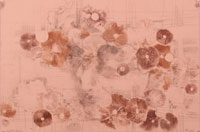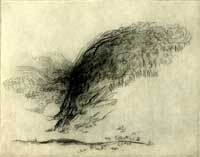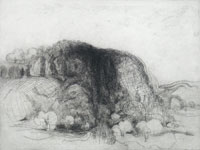Printmaking Communities
by Robert Sievert

Circles And Self

Gerald Marcus No. 2

Gerald Marcus: Southwest Butte Etching
Earlier this year I saw a show, Westbeth Printmakers, that featured the work of a group of artists living and working in Westbeth, an artist residence in the West Village. There are so many wonderful artists, writers and musicians living together in a 15-story block square building. They have dance studios, community rooms. theaters and as it turns out, a print room.
The prints were admirable but in fact unrelated. I wondered at the time if they printed together or at separate times. Was this a cohesive working group?
I myself work in a group of printmakers and so the opportunity to see another group was highly interesting. The assembled prints were varied and quite different in nature. A commonality or group trait seemed like an interesting possibility. But, alas, there was no trace of it. As a group each artist stood apart in an independent pursuit.
Perhaps the most interesting work to me was Frances Seigal's spore prints. Very delicate in nature, she accomplished them by placing mushrooms over sensitive paper and then letting them drop their spores onto circular overlapping patterns. She added delicate washes and lines that gave the work an overall completeness.
I got a chance to sit down with Frances and chat about the printmaking shop at Westbeth. She told me that for the most part it was a place that people went to work independently. There was no interaction between artists. This was disappointinting to me but she said that Jerry had a more comprehensive take on it and I should talk to him. She was talking about Gerald Marcus, her husband and another member of this show.
When I caught up with him several weeks later we spoke about the print shop at Westbeth. He told me that at one time it was a functioning group but it was at this time a place where artists went independently to work. He said that in the past people worked together. He said that the group dynamic broke down over minor issues such as dealing with the equipment. Some one had misused a press blanket, that sort of thing.
Marcus's work in the show was strikingly beautiful. He did simple etchings of Southwestern landscape, when I say "simple", I mean he accomplished his images with just delicate, elegant lines built up into cliffs and canyons and substantial rocky formations.
Other work of interest was Francia's iconographic reductive blockprints derived from plans of medieval cities and walled castles. Graphically interesting, they had a strong sense of architecture.
When I mentioned previously that I was a member of a group it is with renewed respect and admiration that I see my group. About five years ago I attended a workshop in monoprints at the Art Lab run by Herman Zaage. I loved the prints and signed up for Herman's class and a whole new door opened for me.
Herman was a master printer. His specialty was mezzotints but more than anything Herman was a great humanist and teacher whose strength lay in his humanity. His death this Spring was a blow to the Staten Island Art World and to me, who lost a great master.
Herman's classes were always the same. The first session was spent with Herman demonstrating the various forms of printing available in the shop. From there on down each student was on his own to develop his work in the direction that most interested him or her. It took me four years to get beyond collagraphs.
There was definitely a group dynamic going on. We took and borrowed from each other technically and artistically. Susan Grabel, AnnMarie McDonnell, Phyllis Featherstone, and Herman. Herman was always on me for my rolling techniques. I had made this collagraphic plate of house on a hillside. His demonstration of rolling techniques turned out to be a party where everyone was taking turns rolling ink onto my little houses. Such a good time!
Herman was always willing to work with you on printing a plate, and when he printed one of your plates it was always so much better than what you could do.
I hope our group goes on, but whether it does or don't I realize that I have had an extraordinary group experience. I wonder if that is what is was like in pre-war Germany with Die Bruke?
 back to Contents page
back to Contents page